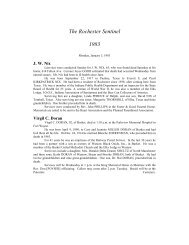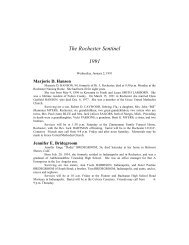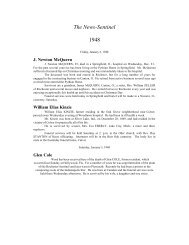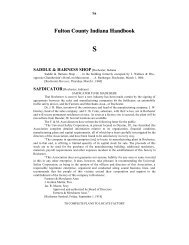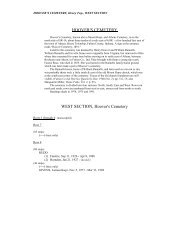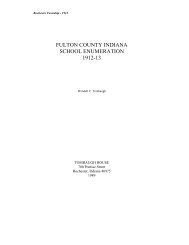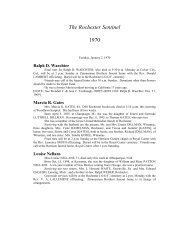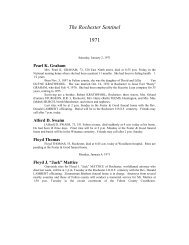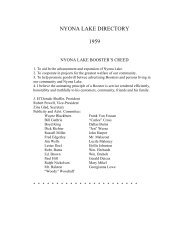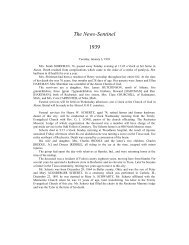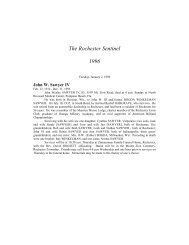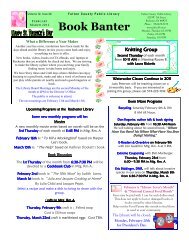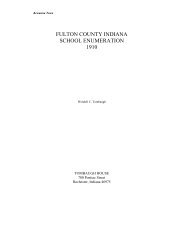Handbook N-P - Fulton County Public Library
Handbook N-P - Fulton County Public Library
Handbook N-P - Fulton County Public Library
Create successful ePaper yourself
Turn your PDF publications into a flip-book with our unique Google optimized e-Paper software.
Po<br />
By Job V. Pownall<br />
In March, 1844, in company with my parents, I came to <strong>Fulton</strong> county by wagon from<br />
Ohio, stopping for a time at Adamsboro, Cass county, where we moved into a log cabin on the<br />
banks of Eel river. Tht same fall pap came on to <strong>Fulton</strong> county and entered a small tract of land<br />
on the west line of Liberty township, within one mile of what is now called Marshtown. Here he<br />
erected a round log house, twenty feet square, with a large fireplace built of stone and a stick<br />
chimney. There was the customary clapboard roof laid on ridgepoles, a hewed puncheon floor,<br />
and door hung on wooden hinges. There was a wooden latch on the inside, with a string to it,<br />
which passed through a hole in the door and hung on the outside. Kitchen, parlor, bedrooms were<br />
all in one, and we had no difficulty in making choice of place.<br />
At the huge fireplace mother did the cooking. Our bread was baked in an oven which she<br />
set on the coals, covering the lid with more live coals. It was mostly corn bread, quickly baked,<br />
but on Sunday morning we always had warm biscuit.<br />
The country was new, therefore a wildernss and swamps. We therefore contracted ague,<br />
and had it to our satisfaction. It was an easy matter to kill squirrels, turkeys, pheasants and ducks.<br />
I once killed a deer and immediately took a chill. Was told by Oliver Bryan that I had “buck<br />
fever.” Where we once pulled cattle out of the mud and shot ducks and geese, is now the finest<br />
corn land in the township.<br />
One morning mother was salting the cows, not over ten rods from the house. Soon<br />
afterward a deer was observed licking salt with the cattle. Mother stepped behind the house and<br />
called to David BanBlaricom, who had just passed, going to the home of Uncle Erwin Barker’s.<br />
Having his gun with him he came quietly to the front of the house, waited until the deer was<br />
separated from the cattle, then fired and down came the deer. A dog belonging to VanBlaricom<br />
was anxious to finish killing the deer, but his master would not consent, so began to reload his<br />
gun, when up jumped the deer and ran away, and that was the last Dave saw of him.<br />
Pap built a calf pen, joining it to the cabin, and in it was a young calf. One night when<br />
pap happened to be away from home the wolves put in their appearance, apparently intent on<br />
having a meal on fine veal. They made the air ring with their growling, but mother kept them<br />
away by throwing fire brands out of the window. Thus the calf’s life was saved by the fire. Our<br />
neighbors kept a few fine sheep for the purpose of raising wool, from which to make their<br />
clothing. Strong pens had to be built, and the sheep put therein every night, to protect them from<br />
wolves. From spring until fall was a busy time, especially during sheep-shearing time. Pap would<br />
catch the sheep and lay them on a platform, where they were tied down, and mother would take a<br />
common pair of shears and cut the fleece, which was washed, then picked to remove dirt and<br />
burrs. It was then put in a sheet, which was pinned with a thorn, and sent to the carding mills.<br />
When it was returned, mother would get out her old wool wheel and spin the rolls into yarn. It is<br />
forty years since mother was called to her heavenly home, yet in my imagination I can still see her<br />
as she tripped back and forth across the puncheon floor, spinning, spinning the yarn that was to be<br />
converted into clothing for her children. When finally done, the yarn was colored blue, then taken<br />
to her sister, Mrs. Edwin Barker, who wove it into jeans for the men’s clothing and into linseywoolsey<br />
for herself and daughter.<br />
Pap sowed a small patch of flax. After it matured it was pulled, spread on the ground to<br />
rot sufficiently to break on the flax break. It was then skutched, then heckled, and then it was<br />
ready to spin on the flax-wheel. In this way mother made her own flax thread, and it was far<br />
superior to the flax thread of present day manufacture. With it she made our clothing. Pap made<br />
all our shoes, making his own wax and shoe pegs. A pair of shoes was supposed to last a year, for<br />
we went barefooted Sundays and week days.<br />
When we needed a doctor, that meant a trip to Logansport, and when we went to mill, we<br />
went to Springcreek mill, run by Henry Miller. Pap had some of his Virginia meal sacks which<br />
held three bushels. They were home-made from the flax of their own raising. He would put a<br />
grist in a sack, throw it over the gray mare and set me on top and start me off for the mill. Those<br />
were the happiest days of my life.




